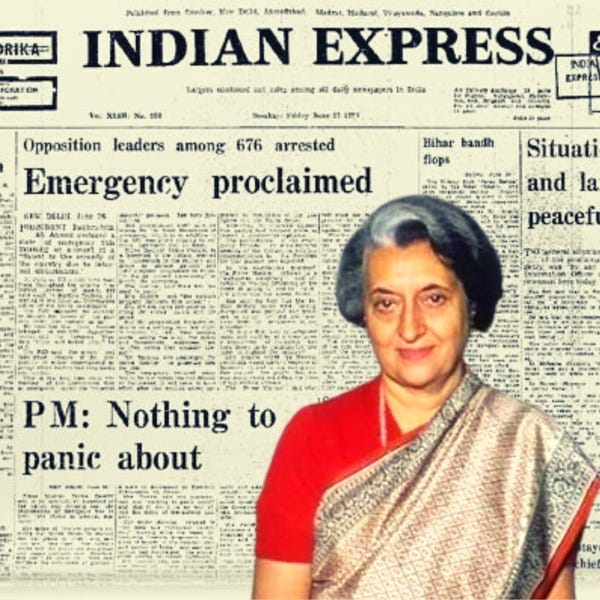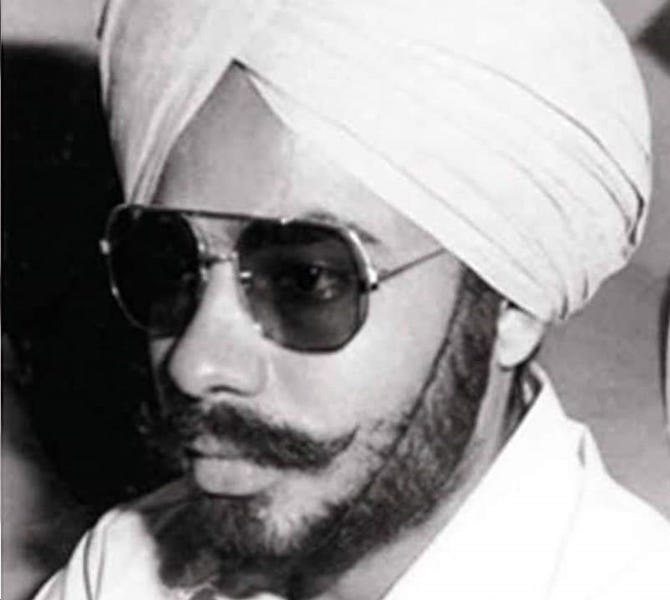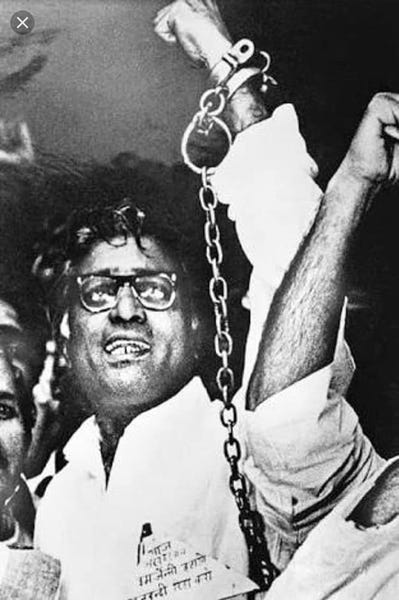On 25th June 1975, just a few minutes before midnight, a state of Emergency was proclaimed by President Fakhruddin Ali Ahmed on the recommendation of Indira Gandhi, the then Prime Minister of India. It remained in effect till 21st March 1977. That darkest chapter of independent India’s history was marked by indiscriminate incarcerations, ruthless stifling of dissent, and an unprecedented clampdown on fundamental rights and civil liberties. That period shook the very foundations of the world's largest democracy and weakened its institutions.
Trigger
On 12th June 1975, the Allahabad High Court voided Indira Gandhi’s election from Rae Bareli in the 1971 Lok Sabha elections, held her guilty of electoral malpractices and barred her from holding any public office for six years. This was the second big jolt, after the previous day's loss in the Gujarat Assembly Election to Janata Morcha - a coalition of parties, including Congress (O) and Bhartiya Jan Sangh. While she had control over her own party, politically, things were on a steady downward slide for Gandhi due to inflation, rising unemployment, corruption, strikes, agitations and Jayprakash Narayan movement. The assassination of Railway Minister Lalit Narayan Mishra in a bomb blast in January 1975 had fueled rumours that he was politically eliminated.
The day of the Allahabad High Court verdict, Supreme Court Justice V. R. Krishna Iyer, who happened to be the vacation judge, received a meeting request from Indira’s Law Minister to discuss the verdict, which the Judge declined. On 24th June 1975, Supreme Court ruled that Indira could continue as Prime Minister pending the resolution of her appeal but ordered all privileges she received as an MP be stopped, and that she be debarred from voting in Lok Sabha.
Next day, Jayaprakash Narayan (JP) led a huge political rally in Delhi’s Ramlila ground announcing a nationwide agitation to demand Gandhi’s resignation. JP recited Ramdhari Singh Dinkar’s poem, “सिंहासन खाली करो कि जनता आती है” (vacate your throne as public is coming). That night, President Fakhruddin Ali Ahmed received Indira Gandhi’s letter requesting a proclamation of Emergency under Article 352 (1). The President did not have the benefit of advice from the Council of Ministers, as Constitutionally required. This was because Indira had kept the Cabinet unaware of what was happening, citing she had ‘no time to lose’ given an imminent threat to India’s internal security (the Cabinet gave post-facto approval). A few minutes before midnight, the said Article of the Constitution was invoked for ‘internal disturbance’, and a national Emergency was imposed. After signing the death warrant for the Indian democracy, the President took a tranquiliser and went to sleep. On 26th June at 8 am, Indira Gandhi did a radio broadcast to inform the country about the late night attempted murder of the democracy.
Indira Gandhi was being advised by a core group – Siddhartha Shankar Ray (the then West Bengal Chief Minister), DK Barooah (the Congress President), HR Gokhale (Law Minister), and Rajni Patel (President, Bombay Pradesh Congress Committee). While the events in June and the impending agitation precipitated the Emergency, some reports indicate that the consideration, if not the planning, for Emergency was ongoing for quite some time. In a letter to Indira Gandhi on 8th January, Ray proposed the imposition of an internal Emergency and outlined the series of steps to be followed. Some media reports suggest that the list of people to be arrested was also being compiled from January 1975.
Arrests
JP, Morarji Desai, Vijayaraje Scindia, Atal Bihari Vajpayee, LK Advani, Charan Singh, George Fernandes, Madhu Dandavate, Ramakrishna Hegde, Nanaji Deshmukh, Piloo Mody, Sikander Bakht, Arun Jaitley, Ashok Mehta, Raj Narain (who filed a case against her leading to her disqualification), and many more across the country were immediately arrested. Dissenting members of the Congress like Chandra Shekhar, Mohan Dharia and Rani Dhan were also arrested. At least 100 leaders were arrested before dawn of 26th. Five future Prime Ministers were put behind the bars - Morarji Desai, Charan Singh, Chandrashekhar, Atal Bihari Vajpayee and HD Deve Gowda – and so were several former and future chief ministers. One can read the list of arrested political leaders here: Biju Patnaik, Prakash Singh Badal, Mulayam Singh Yadav, Lalu Prasad Yadav, Nitish Kumar, Bangaru Laxman, Pramod Mahajan, Gopinath Munde, and many more. Freedom fighters including Dr Sushila Nayyar, Acharya Kriplani and H V Kamath were arrested from Rajghat for protesting on Gandhi Jayanti. Congress (O), Jana Sangh, Bharatiya Lok Dal, Socialist Party, Akali Dal, CPM, DMK, etc. opposed the Emergency.
The Rashtriya Swayamsevak Sangh (RSS) Sarsanghchalak Balasaheb Deoras was arrested on June 30th, and RSS banned on July 4th. Thousands of Swayamsevaks were arrested during the period. As of 12th February 1977, out of the total 6,330 persons still detained under the Maintenance of Internal Security Act (MISA), 3,254 were from RSS and 772 were from Jana Sangh. This was after the Emergency regime’s order on 18th January 1977 to release all political prisoners.
In total, twenty six political organisations were banned. Many leaders and activists went underground. At that time, Narendra Modi was appointed as the General Secretary of the 'Gujarat Lok Sangharsh Samiti,' a committee of the RSS that coordinated opposition to the Emergency in Gujarat. He remained in disguise to effectively coordinate protests.
Sitaram Yechury, a Jawaharlal Nehru University student, was active in protests against the Emergency. Yechury went underground, but was picked up by the police the day he brought his father home from hospital after a surgery. "That was the kind of surveillance,” he said.
On January 31, 1976, the DMK government in Tamil Nadu led by Karunanidhi was dismissed and President’s rule imposed. It was one of the two strong opposition governments, the other one being in Gujarat, which fell six weeks later. The day after the DMK government was dismissed, police came looking for Karunanidhi’s son, MK Stalin. In Part-1 of his autobiography, Tamil Nadu Chief Minister MK Stalin has recounted his arrest in 1976 and described the jail time as a 'torture camp' that ‘reverberated with wail’. Ironically, Stalin’s said autobiography was released in 2022 by Indira Gandhi’s grandson Rahul Gandhi.
Indira was Congress, Congress was Indira
The Congress Parliamentary Party barring five — Chandra Shekhar, Mohan Dharia, Ram Dhan, Krishan Kant and Laxmikanthamma – supported Emergency. Those five were suspended and arrested. The rest bowed to Indira Gandhi.
The Communists Party of India also supported the Emergency. Interestingly, the first government to be dismissed by PM Jawaharlal Nehru invoking Article 356 was the CPI government in Kerala. Eventually, in 2015, CPI leadership admitted that supporting the Emergency was a political mistake. Shiv Sena also openly supported Emergency. Some prominent personalities like JRD Tata, Vinoba Bhave and Khushwant Singh were also supporters of the draconian period.
The Emergency Horrors
Rampant human rights violations, including the targeting of dissenters through surveillance, intimidation, arrests and incarceration without trial, thereby creating a climate of fear and repression that resulted in self-censorship.
Countless cases of torture of detainees, including custodial deaths, were reported.
The district magistrate of Chandigarh, where JP was detained, mentioned JP’s deteriorating health to the government. The then defence minister, Bansi Lal, replied: “susrey ko marney do.” (Let the swine die).
Mrinaltai Gore, fondly called ‘paaniwali bai’, who had become a Member of Legislative Assembly in Maharashtra in 1972 with the highest margin in the State and who later became MP in 1977, was arrested on 21st December 1975 and was in prison for 15 months. She was put in a barrack that had no window, with a criminal in an advanced stage of leprosy in the adjoining cell, while a violent lunatic prisoner was in the opposite cell.
Activist and actress Snehalatha Reddy was arrested along with George Fernandes in the Baroda Dynamite case (the final charge sheet did not contain her name). She was held without trial for eight months in Bangalore Central Jail and was subjected to regular torture. Her asthma became chronic due to the deplorable conditions that she was kept in. On two occasions in prison, she went into an asthmatic coma. She was released on parole in January 1977 due to deteriorating health but died five days later as a result of a debilitating lung infection and poor medical treatment while in jail.
George Fernandes’ brother Michael was arrested in December 1975 and spent 15 months in jail, enduring severe torture during his detention. His other brother Lawrence was arrested on 1st May 1976 and brutally tortured to extract information about George’s whereabouts. In jail, he was continuously beaten, resulting in multiple fractures all over his body. When he was released after the end of Emergency, he looked like a skeleton, and was a mental and physical wreck for many years.
Snehalatha and two Fernandes brothers were arrested and tortured over mere association with George. Madhu Dandavate, who was also in the same jail as Snehalatha and Lawrence, wrote in his memoir, "I could hear the screams of Snehalata from her cell in the silence of the night". He also wrote a letter to Indira that Lawrence was being inhumanely tortured and may even die.
The most horrific case was that of young P. Rajan, a final year engineering student who was wrongly picked up by the Kerala police for a crime he did not commit and which could have been easily verified. He was tortured, killed and his body never found. Years later, media reports emerged stating that Rajan’s tortured and mutilated body was initially dumped in an ice chamber and subsequently ground and fed to pigs in a Government meat factory.
Instances of police firing on protesters across many parts of India. The horrific killings at the Turkman Gate in Delhi and at Kairana and Sultanpur in Uttar Pradesh.
A crackdown on labour unions and trade strikes.
Atrocities were committed during slum evictions and demolitions in urban areas, particularly in Delhi, under the guise of beautification drives, with no prior notice given to slum dwellers.
There was a severe curtailment of freedom of speech and expression.
Films and artists were banned, including Aandhi (believed to be based on Indira’s life), Kissa Kursi Ka (a spoof on the Emergency), Dev Anand, Kishore Kumar,... Kumar’s was the worst case. In January 1976, he refused to sing in praise of the Indira government, so a miffed I&B Ministry banned him from the All India Radio and Doordarshan. None of his songs or films were allowed. The Ministry even ordered that the sales of gramophone records of his songs be frozen.
The Justice Shah Commission of Inquiry, which investigated the abuses during the Emergency, revealed that during the Emergency period nearly 110,000 people were arrested under the Defence of India Rules and MISA. This included politicians, freedom fighters, journalists, academics, social activists, student leaders, trade union leaders, and commoners opposing forced sterilisation or slums demolition. Many were detained without trial for months. The Emergency regime had arbitrarily arrested anyone and everyone that it deemed hostile or unfavourable. On 18th January 1977, Indira Gandhi called fresh elections for March and released all political prisoners. The Emergency was officially revoked on 21st March 1977.
DYK: The Forgotten Emergencies
Most Indians do not know that 1975 was the third time that Emergency was imposed in India.
The First National Emergency was proclaimed during PM Jawaharlal Nehru tenure on 26th October 1962 in view of the Indo-China war. Even after the ceasefire was declared a month later, the Emergency was not revoked, and was in force during the 1965 Indo-Pak war, continued even after the Tashkent Agreement, until it was finally revoked on 10th January 1968.
The Second National Emergency was proclaimed under PM Indira Gandhi on 3rd December 1971, and was not revoked after Pakistan signed the instrument of surrender two weeks later. So, when the Third National Emergency was proclaimed in 1975, Indians came under ‘double Emergency’ - internal as well as external aggression. Both the proclamations of Emergency, 1971 and 1975, were revoked in 1977.
Part II: Emergency 1975: Press Censorship, Mass Sterilisation, and Shades of Justice
Part III: Emergency 1975: A Haunting Legacy
I urge you to read, tweet, write, share, and raise awareness about the dark era of Emergency. Together, let us ensure that these facts reach as many people as possible, especially the younger generation, so that we never forget the horrors, and actively work to safeguard our democracy.
X: @semubhatt






